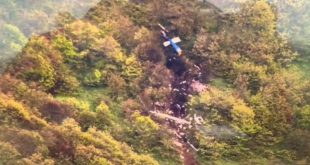An archaeological site in northeast Spain holds one of the oldest-known Muslim cemeteries in the country, with the discovery of 433 graves, some dating back to the first 100 years of the Islamic conquest of the Iberian Peninsula.
The finds confirm that the region, along the frontier between the warring Islamic and Christian worlds in the turbulent early Middle Ages, was once dominated by Muslim rulers, who were later replaced by Christian rulers and their history forgotten.
The archaeologists unearthed the ancient graves from a maqbara or Muslim necropolis, dating from between the eighth and the 12th centuries, this summer in the town of Tauste, in the Ebro Valley about 25 miles (40 kilometers) northwest of Zaragoza.
The remains show that the dead were buried according to Muslim funeral rituals and suggest the town was largely Islamic for hundreds of years, despite there being no mention of this phase in local histories.
“The number of people buried in the necropolis and the time it was occupied indicates that Tauste was an important town in the Ebro Valley in Islamic times,” lead archaeologist Eva Giménez of the heritage company Paleoymás told Live Science.
Giménez and the company Paleoymás were contracted for the latest excavations by El Patiaz Cultural Association, which was founded by local people in 1999 to investigate the history of the town.
Their initial excavations in 2010 suggested that a 5-acre (2 hectares) Islamic necropolis at Tauste might hold the remains of up to 4,500 people. But the association’s limited funds meant only 46 graves could be unearthed in the first four years of work.
Giménez said the latest discoveries hint that even more Muslim graves could still be found. “We now have information that indicates that the size of the necropolis is greater than what was known,” she said.
The dead were typically wrapped in a shroud and placed lying on their side, with their gaze facing towards Mecca. (Image credit: El Patiaz Cultural Association)
Archaeologists say the ancient burials at Tauste were carried out according to strict Muslim funeral rites, without grave goods or signs of social distinction. (Image credit: El Patiaz Cultural Association)
The latest excavations at Tauste focused on a single road known to pass through the ancient Islamic necropolis. The remains of 433 people were unearthed there who had been buried according to Muslim funeral rituals. (Image credit: El Patiaz Cultural Association)
The Islamic phase of Tauste’s history had been forgotten – perhaps deliberately – and ancient graves sometimes found in the town were dismissed as those of victims of the 19th-century cholera pandemic. (Image credit: El Patiaz Cultural Association)
Archaeologists think up to 4,500 bodies may have been buried in the ancient necropolis at Tauste over 400 years of Muslim rule. (Image credit: El Patiaz Cultural Association)
The discovery of hundreds of people buried according to Muslim riites between the eighth and the 12th centuries indicates Tauste was an important local centre of Islamic culture. (Image credit: El Patiaz Cultural Association).
The graves also showed other distinctive Muslim features: They were just large enough to accommodate the body, and the dead were buried in a white shroud, regardless of their social status, she said. To this day, Muslim rituals do not allow the dead to be buried with grave goods, but fragments of ceramics found nearby in the excavations since 2010 showed they dated to between the eighth and 12th centuries, Giménez said.
While the existence of the Islamic graveyard was known from the earlier excavations, “what was not known were the dimensions and density of the tombs,” she said. “It has been expected and unexpected at the same time.”
The latest discoveries, in a single street known to be part of the ancient necropolis, show the extent of Muslim influence in the town over several centuries.,
The cemetery was in use continuously for more than 400 years, they found. “This tells us about a constant and deeply rooted [Islamic] population in Tauste since the beginning of the eighth century,” Giménez said.
Originally published on Live Science.
 صراط عشق صراط عشق
صراط عشق صراط عشق




